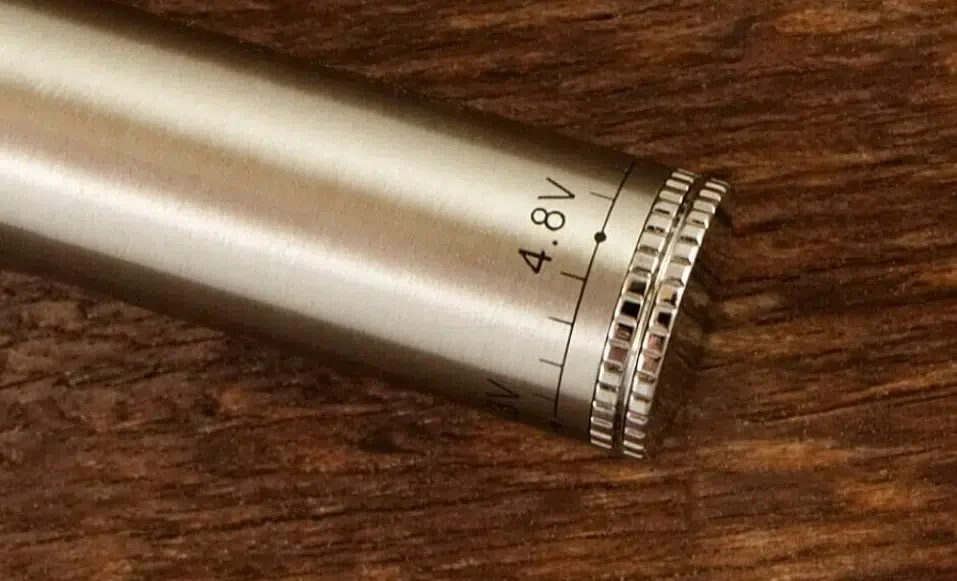
The other day, I was scrolling through newb vape Reddit, and I came across a beginner vaper asking about the best vaping voltage for their vape pen.
The answers were… less than illuminating, I have to say.
Experienced vapers started sharing advice left and right, writing things like: ‘Oh, but you have to take into account your coil resistance!’… or further confusing the matters with: ‘It’s not about voltage, it’s about wattage’… and silly things like that.
Look, when you’re just starting out vaping, these terms — wattage, voltage, variable wattage, variable voltage, battery output, coil resistance — are all confusing!
I get it.
So I’ll do you a solid here — I’ll demystify this as much as possible!
Keep in mind that whatever you read in this post applies only if you’re using simple vape pens — the ones that utilize cartridges and don’t need too much power. This does not apply to box mods that have temperature control or circuitry that allows you to control your watts output. So if you have a pen that’s marked 2.5v or 4.8v, this is for you.
Let’s dig into it!
The Difference Between Voltage and Wattage?
Now, let’s get focused here because this physics thing gets confusing real fast.
While both wattage and voltage have something to do with the power inside your vape device, they are not one and the same.
What is Voltage?
Voltage is what makes electric charges move. It is the ‘push’ that causes charges to move in a wire or another electrical conductor. Think of it as the amount of power that is going through your device. Now, do keep in mind that other things can factor into your overall power output, such as coil resistance.
What is Wattage?
When talking about wattage, I’m referring to the amount of power your device puts out. This means that your device will produce the voltage that corresponds to the wattage you’ve set it at [taking into account your coil and the ohms it’s creating].
Think of it like this – wattage is your autopilot. It does the voltage correction for you when your coil resistance goes up from use. For example, it jumps from 1.8 Ohms to 2.0 Ohms. Now, you’ve got to adjust your voltage to compensate for that.
When you’re using a variable voltage vape pen, you have to do this yourself. You’ll notice that your hits are getting weaker as the coil resistance goes up, and you’ll adjust.
Voltage to Wattage Conversion [With Your Coil in Mind]
Buut…
Let’s say you want to get really science-y about it all.
In that case, you can convert your volts into watts — just to keep tabs on how much wattage you’re sending to your e-cigarette. Keep in mind that, when you increase the volts, the watts go up, too [so you get your battery to fire at a higher wattage, so to speak]. And it’s true vice-versa — when your wattage goes up, your voltage increases. The output that you get with your volts depends on the resistance of your coil [so the Ohms — resistance — you have on there.]
These calculations are a pain if you’re doing them by hand. So… here’s a handy little calculator that will do it for you because… math, amirite?
Now that you know that, let’s take a quick look at how higher voltage [and lower voltage, too], affect your vaping. This will be particularly useful if you own a variable voltage vape pen that lets you adjust your settings for the best vaping experience.
How Does Voltage Affect Your Vaping?
Though I’m nowhere near to being an engineer, I have more than enough trials and errors to help you figure out what would be good practice here when it comes to your vaping.
The setting that you settle on will be a matter of personal preference and the vaping experience you’re going for. It will affect everything from throat hit, desired vaping effect, the taste of your vape juice, the intensity of the flavor, and all those things.
My goal here is to help you find your sweet spot and help you understand the pros and cons of higher and lower voltage.
Temperature
Higher voltage will make your vapor warmer, there will be a lot of it, and you’ll use up vape juice in your tank much quicker. On the other hand, a lower setting provides vapor that is much colder and won’t be as thick or in large quantity.
Flavor
The flavor of your vape might depend on the temperature you’re generating. Higher voltage produces higher temperatures, which can make some flavors really pop.
If you’re using dessert-type flavors, a higher temperature is better suited because of the complexity of the flavor profile. On the other hand, if you’re using menthol as an e-liquid, lower power level with lower temperature is better because you want to get that cooling sensation.
Hit
The fact that your device is heating up the coil much faster on higher voltage doesn’t give too much room for the cotton to soak up, so consecutive puffs can easily end up with a burnt flavor. But, if you go to the other side of the spectrum and go too low on voltage, you might experience a bit of spit back due to too much liquid build-up inside the cotton and your coils might clog up (especially if you’re vaping some sweet, cake/pastry-based e-juice) faster.
Coil Lifespan
Your coils will get used up faster the higher voltage you put through them. Of course, each coil comes with the recommended range, so I would highly recommend you stick to it. Don’t get me wrong, nothing bad is going to happen to your device if you are on the higher end of your coil’s recommended power output, but you can expect it to run on you sooner than later.
On the other side, as you might assume, keeping your settings low, will definitely prolong your coil’s lifespan.
Inhale
It’s important to understand that a higher setting heats the juice much faster, so when you inhale the vapor it will be quite hot. So, if you enjoy prolonged inhales, lowering your setting is a way to go. No one and I assume you as well, doesn’t like to burn your throat with piping hot vapor.
Battery Life
Ok, so you can already figure out the pattern here. Are you a long way from your charger and your vape pen is running low on energy? Well, lower the power and you will increase its battery life. It’s that simple.
Burning through your vape juice will also affect your variable voltage battery, aside from coils, juice, cotton, etc…
Airflow Settings
And while this is totally up to you, deciding which airflow setting would suit you the best also depends on the voltage.
Lower voltage gives you more room to wiggle, so you can basically completely close the airflow and be sure you won’t burn anything inside your pen while the temperature rises up gradually.
Choosing Your Ideal Voltage
Ideal voltage is a bit broad term since every device has its own performance curve, a space where they operate the best and give the finest results. It would be nearly impossible to go ahead and list all of them and their peak performances, but there are some simple rules you should abide by when starting to experiment with your current device. Do keep in mind that most vape pens go from 2.0 to 4.8 volts.
So, if you are more of a happy trigger finger, I recommend starting low and building your way up. By no means am I saying that you would need to start from 0.1 and build up by .1 every now and then. As I mentioned before, your coil will give you a rough estimation and range in which you can operate.
This one is more of a piece of advice, the higher you go doesn’t necessarily mean your vaping experience will be automatically better. I would rather stay well under 3.1 volts and enjoy the flavor, puffing out discrete vapor and keeping my higher resistance coils running for a longer time.
Another thing you will probably notice is that most devices and coils don’t really need to go full power. For example, if you are already around 4 volts you will most likely have the same experience as when you’re maxed out.
Best Voltage for Flavor
Getting the most out of your favorite tobacco-flavored e-juice can be a challenge if your device isn’t at an adequate temperature.
Now don’t get too confused, I’m mentioning temperature simply because set voltage determines how high or low your coils will heat up.
While tobacco flavored liquids are a safe choice when it comes to messing up the right temperature, some more delicate flavors won’t be. To be completely honest, there isn’t a specified temperature that will work 100% of the time.
When it comes to flavor, anywhere between 320°F to 356°F (160°C to 180°C) for great taste and from 356°F to 392°F (180°C to 200°C) for good taste.
The reason for dividing great and good is because the vapor production will be less noticeable at lower temperatures. So, let’s say the range between 356°F to 392°F is middle-ground for good flavor and a fair amount of vapor production.
Best Voltage for Clouds
First of all, ok I get it. It’s totally fun bursting massive amounts of vapor and I did that at the earlier stages of my vaping journey. And for that sole reason, I will cover that part too.
The higher you go with your voltage the more vapor your vaping device produces, it’s that simple. Do keep in mind you’re sacrificing flavor, battery, coils, and cotton to achieve that thickness. Also, your tank will be empty before you can blink and you risk dry hits.
Now, it’s completely fine to do it occasionally, but don’t make a habit out of it. Vape pens are by no means built to handle massive clouds.
But, if you are really into the cloud chasing game, maybe look into more powerful devices, because these ones won’t cut.
CONCLUSION
Now that you understand how voltage affects your vaping, it’s time to choose the best one for you. If the flavor is more important to you than vapor production, then decrease your voltage a bit until you find the sweet spot, try vaping anywhere around 2.3 – 3.5 volts.
However, if you’re looking looking for decent clouds and continued usability, you will have to adjust your variable voltage accordingly.
Just keep in mind that a variable volts vape pen is a bit more hands-on… but it’s not that difficult to figure out. And as always, preferences vary, so it may take some experimentation before you find the perfect settings for your device and what works best for you.
